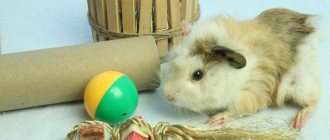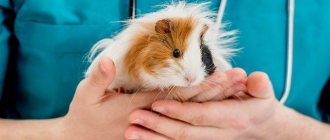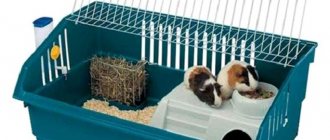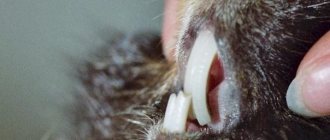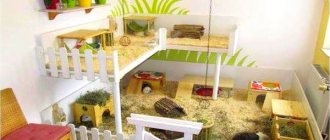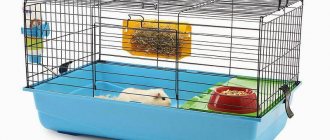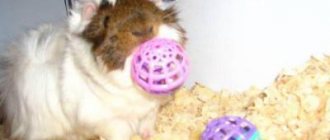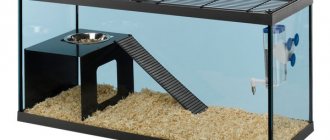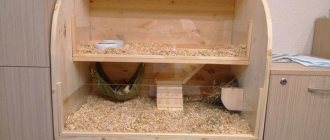Guinea pigs are energetic and funny animals that are purchased for positive emotions. Pets bring joy if they are healthy, well-groomed, and willing to interact. It is important to initially get a young animal so that it can please its owners for a long time. After all, the animal’s eyelid is not that long. Sometimes it becomes necessary to determine the age of a guinea pig. How to do it right?
Additional factors affecting health
Besides food, there are other factors that affect the health and lifespan of guinea pigs.
If their cage is too small, they will have little room to run around. With a lack of activity, their muscles will not develop properly, and their overall fitness will be far from healthy. Regular cage cleaning also promotes good health. In case of illness, the owner should immediately contact a veterinarian. It is also recommended that guinea pigs be weighed weekly, as weight loss is the most common and common symptom of a disease or disorder. Besides weight, other symptoms may include shortness of breath, heavy breathing, sneezing, lethargy, diarrhea, and blood in the urine. Prompt attention to these types of health problems will certainly increase your pig's possible lifespan and allow him to reach his full potential.
A popular pet, the guinea pig or cavy, is found in many homes. Animals are bought for children, they are bred for exhibitions and shows, as a hobby. Some breeders become so accustomed to their furry pet that sudden death becomes a real blow and shock. To minimize the experience and bitterness of loss, you need to know how many years guinea pigs live and what affects their life expectancy.
The guinea pig is a rodent domesticated thousands of years ago, distinguished by its funny appearance, good-natured character, intelligence, sociability and good health. They are unpretentious in maintenance, do not create problems at home and take up very little space. The average weight of an adult rarely exceeds a kilogram.
Wild pigs live no more than 8 years, but most often no more than five. This is due to the presence of predators, problems with food and diseases.
In captivity, animals live much longer, up to 15 years. There are cases where kavia lived for 20 and even 25 years. However, how long a guinea pig lives at home depends on many factors. Among them:
- Breed,
- Presence of diseases
- Genetics,
- Proper feeding
- Tribal use,
- Proper care.
- Influence of breed on lifespan
Today, breeders have obtained more than 80 breeds of cavy. Breeds differ from each other in appearance, color, character, human orientation, hair or lack thereof. Many people think that this is where the differences end.
Hairless guinea pigs will delight their owners for fewer years. They were obtained by long crossing within the same type, as a result of which not only a recognizable appearance was established, but also weak immunity. The first animals rarely lived to be four years old, but today, thanks to the partial influx of blood from ordinary pigs, their life expectancy has increased to six years. However, in order for the skinny to live a long life, it needs constant certain conditions of detention. The temperature in the room where the cage is located should not be less than + 22 and more than + 25 degrees. The animal's skin is equally susceptible to both cold and heat. Too dry air can cause peeling and cracking of the skin, and too humid air leads to the appearance of fungi, lichen and other skin diseases.
The life expectancy of Abyssinian and Curley guinea pigs is also not long and is about 7 years. This is also due to genetics and the characteristics of animal breeding. They are quite demanding to care for and are often susceptible to various diseases. Smooth-haired Satin and Dalmatian guinea pigs will delight their owners for about eight years.
Peruvians, as well as teddies, selfies, agoutis, rexes and alpacas, are distinguished by good health and unpretentiousness and live much longer - from 10 years.
Owner reviews
Of course, the cost of a purebred rare pig is not always affordable for the average buyer, but if you want to engage in professional breeding of such popular rodents, your choice should be on animals with an excellent pedigree.
This is interesting! Pig breeding in our country has not yet reached foreign heights, but already now connoisseurs of decorative rodents are striving to acquire pets with an original and exotic appearance.
Experienced owners are categorically against crossing representatives of long-haired and short-haired breeds, since all the resulting offspring will be classified as low-quality mestizos that do not take part in exhibition shows. Among other things, the inadmissibility of mating representatives of heterogeneous breeds is due to the inhibition of the development of breed qualities.
In any case, the guinea pig is rightfully one of the best pets, especially for anyone who is trying to get an animal for the first time. This animal is unpretentious in care and easy to keep, very affectionate and quite sociable, so it is ideal for home keeping even in families with children.
Return to content
Where does a guinea pig live longer - in the wild or in a cage?
This is an encyclopedic question to which there is no clear answer for 3 reasons:
- lifespan depends not only on living conditions: heredity and accidents influence in the same way as living conditions and the presence of enemies in the wild;
- a caring owner can extend its lifespan through good care;
- In the wild, natural selection of guinea pigs occurs: individuals remain that are less sick, run away faster and adapt better.
Parents who buy animals for children are interested in how long guinea pigs live at home, because the pain of losing a beloved pet is extremely stressful for a child. Life expectancy depends on the breed and care.
How long do guinea pigs of different breeds live?
Animals of different breeds live different numbers of years. Breeds formed in the wild underwent natural selection: only the strongest individuals survived. Therefore, such rodents live up to 10-12 years.
We suggest comparing the life expectancy of different breeds of guinea pigs using the table:
How to extend the life of a guinea pig
It is generally accepted that those varieties of guinea pigs that have been bred through selective breeding live shorter lives. The reason is that breeders were not interested in the health of their pets, but in the length, texture of the coat, its color - aesthetic characteristics. But numerous owners are willing to argue, because life expectancy depends not only on heredity:
- Conditions of keeping
: hairless animals can live for ten years due to careful care: if the owner monitors the air temperature, there is less risk of getting sick from hypothermia or heatstroke. The litter is regularly changed and the cage is washed - the likelihood of infectious and viral diseases is reduced. - Nutrition
: A balanced diet is important so that the pig does not lose weight or gain weight. You also need to take into account the characteristics of the breed and the time of year. Hairless guinea pigs need food to maintain their body temperature, so grains are important. The beauty of a long and curled coat depends on vitamins - emphasis on vegetables. In winter, the animals need more energy, so they are fed more densely. In summer, the density of the diet is reduced by 10-15%: food takes longer to digest due to the fact that the pets are warm.
Diseases: the danger is not in the diseases themselves - it is important to notice the first symptoms in a timely manner. Therefore, close contact with the guinea pig, games and stroking help to determine in time that the animal is unwell
There is a lot of information on the Internet that the life record for a guinea pig is 15 years. But nothing is said at all about how this was accomplished. And the whole secret is that she was scrupulously looked after. Want your guinea pig to live longer? — Bookmark this site so that useful articles are always at hand.
It is believed that all domesticated guinea pigs, regardless of breed, have the same life expectancy, and the decisive factors that influence this indicator are care and nutrition. Breeders insist that long-haired and hairless pets have significant differences related to physiological characteristics and especially immunity.
On average, guinea pigs live 5-8 years, depending on the breed and living conditions. Proper care and nutrition will help extend the life of communication with your pet.
General form
Guinea pigs are the size of a well-fed kitten. Their body length can reach up to 35 cm. The weight of male pigs can be up to 1.5 kg, and females – up to 1.2 kg. The body of these rodents is huge and more rounded than that of their wild relatives. Guinea pigs do not have a tail. Their muzzle is blunt, their ears often droop. Color can vary from dirty gray to golden red. The length of the coat varies greatly among different breeds. The temperament of guinea pigs is delightful. They are kind, friendly and naive. It is advisable to keep them in pairs, since pigs cannot stand being alone. It is impossible to drop these animals from a height; this can lead to unpleasant results. The sounds made by the pig are similar to the grunting of ordinary pigs. But at some points these animals can purr, rumble, or even chirp. Guinea pigs eat grains, hay and vegetables. They often need to be treated with vitamin C, because it is not produced in the body of these rodents. There are many different breeds of guinea pigs, which differ in the length of the coat and its design. Caring for different breeds of pigs will also vary. Some species were only bred unnaturally. Such breeds will not survive in the natural world, since their body is not adapted to different air temperatures, they do not know how to get their own food and build a warm home.
Diseases and their impact on life span
Diseases in guinea pigs can significantly shorten their lifespan. The main diseases of domestic rodents include:
Some diseases are deadly for the furry animal, as well as for its owners. If there are alarming symptoms, you should definitely show your pet to a veterinarian, and if the animal dies, an autopsy should be performed to identify the true cause of the disease and the degree of danger to people.
Some viruses that cause death in pigs can cause serious health problems in humans.
Rodent teeth require special care. Naturally inactive teeth grow rapidly, so they sometimes need to be filed down. Teeth that are too long can cause your pet to starve to death. You should periodically have your teeth examined by a veterinarian. The doctor will determine how much trimming needs to be done and perform the procedure painlessly for the animal.
Nowadays most people have pets
, from dogs and cats to snakes and spiders. And now you are faced with the question: what kind of pet should you get?
For a dog, the apartment may be too small (and toy breeds are quite expensive), there may be an allergy to cat fur, but you want to have a little furry friend nearby, whose care will not take much time and will be interesting to play with and watch with the animal. him (for example, you can’t play with fish).
a decorative guinea pig is ideal as a pet.
. After all, caring for them is quite simple, and they don’t require much space; a spacious cage is enough. It won’t cost much to feed a guinea pig either, because all its food is plant-based.
This little pet will get along well with other household inhabitants, if there are any. Therefore, you need to monitor them more carefully, because, for example, a cat can seriously harm the health of a new pet.
Newborns
It is also interesting to know what size a guinea pig should be at birth. The cubs that are born have a height of 5 to 10 cm. In small breeds, the weight usually does not exceed 45–50 g, and in large breeds it reaches 100–120 g.
Much depends on the number of newborns in the litter. The more cubs a female bears, the smaller the size of each of them. Birth order also plays a role. Individuals born first are usually larger than others.
The size of the babies is also affected by the course of pregnancy in the female. If the guinea pig is healthy, then it can bear three large cubs, which at birth will weigh at least 100-120 g.
Cubs are considered newborns under 7 days of age. During this period they practically do not grow.
WHAT TO FEED?
The lifespan of your pet largely depends on nutrition. It is very easy to choose a diet for a guinea pig, because they are herbivores. They eat various fruits, grass, hay
(helps to grind teeth and promotes good digestion),
special food, etc.
But certain proportions must be observed:
- 60% of the diet should be special food for guinea pigs, because it already contains all those components that contain useful substances necessary for the life of pets.
- 20% hay, grass, crackers (not to be confused with store-bought crackers that are sold for people. It is best to dry them yourself, or again, a pet store will come to the rescue).
- 20% vegetables and fruits.
Of course, there are also things that guinea pigs should not eat:
- any products of animal origin except milk and cottage cheese.
- red cabbage (even though guinea pigs are big fans of cabbage in general).
- sweets.
- various fruits and berries that did not have time to ripen or, on the contrary, were overripe.
- spoiled and damp food (check it carefully before giving it to your pet).
Pigs need to be fed 2-3 times a day
(depends on individual characteristics). Serving is approximately 2-3 tablespoons. Guinea pigs need vitamin C, which they can only get from their food. Vitamin C should be given to pigs at the rate of 1 mg per 1 ml of water. This solution needs to be changed every day.
If you keep all these rules in mind and follow them, your guinea pig could become the new longest-living record holder!
Feeding
For a domestic pig to live long, it needs a balanced diet.
. The menu should include:
- special food;
- vegetables;
- fruits;
- hay;
- branches;
- crackers.
Purchased food should be intended specifically for domestic guinea pigs
, other grain mixtures may not be as useful, because the food formulation takes into account the characteristics of a particular rodent. As a percentage, the main share should be dry food (hay) - 60%, the rest is equally divided between solid (grain, peas, corn) and succulent food (vegetables, fruits, herbs).
Many breeders are skeptical about commercially advertised feeds, attributing to them a negative effect on the gastrointestinal tract of domestic guinea pigs. These animals love to eat and are prone to obesity, so you should not overfeed them.
Caring for cubs in the absence of a mother
In rare cases, the mother dies during childbirth or due to infection. The most suitable option is to place the newborns with another lactating female.
In order for her to accept the piglets, the animals' fur is carefully rubbed with sawdust from their future cage. This way a new scent is applied.
Sometimes the fur is treated with camphor oil - this will remove the old smell. After this, the adult pig is temporarily removed from the cage and the foster pigs are placed with her own offspring. With all the precautions, she most likely will not notice the addition, and will take care of the new cubs as if they were her own. No more than 1–2 piglets should be added.
If there is no suitable female nearby, you can feed the animals yourself. To begin with, place a heating pad or other heat source on them. The basis of the diet of newborns is infant formula (formula from birth, from 0 months). Feeding is carried out with a pipette or using a syringe without a needle every 3 hours day and night. After a few days, feeding at night stops. At first, the dose per meal is 0.5 ml. Over time it increases depending on appetite. From 4–5 days, children's vegetable purees or children's dairy-free porridge are given a couple of times a day. Feeding with milk or dairy products is not recommended.
As usual food, they give rolled oats flakes, hay and vegetables in small quantities. The cubs feed on formula for 21–28 days. You can monitor the development of pigs by weighing them daily.
Newborn pigs also need help with bowel movements. To do this, take a piece of cotton wool moistened with vegetable oil or boiled water and massage the abdomen and genitals. Under normal circumstances, this is done by the mother.
How to determine a boy or a girl
In addition to the question of how to distinguish the sex of a guinea pig, you need to find out what behavior a healthy animal should have. Young individuals are very active. They actively move around the cage and react to their surroundings. It is considered a bad sign if the pig sits huddled in a corner. Healthy animals have beautiful fur, a clean nose and ears (without lumps or discharge).
Examine the animal for parasites. It could be lice or lice. The latter are about one millimeter in size. You can see them on bare areas of skin behind the ears.
Now you know not only how to find out the sex of a guinea pig, but also how to determine a healthy individual.
In any case, do not be upset if you find out that for several months you called your pet male or female, and then it turned out that the individual has the opposite gender. Regardless of this, the animal still remains your pet.
Gender recognition in guinea pigs can be a bit difficult when dealing with young animals. It is easy for a young animal to be harmed by an inept attempt to recognize its gender! The easiest way is to examine the anal area. However, if this method does not dispel our doubts, we can resort to one trick. With our left hand we take the pig just behind the front legs and turn it belly up. With the palm of our right hand we clasp the pig in the lumbar region and with our thumb we lightly press on the subperitoneum (lower abdomen) just above the external genitalia. The pressure should initially be light and then slightly stronger.
In males, under the thumb you can feel the penis, which, a little later, protrudes out of the foreskin. If it is a female, then a gap in the shape of the letter Y will be clearly visible.
One of the most common problems for people in the process of choosing a pet is determining the sex of the animal. It is easier if the animal is large in size and its genitals are clearly visible, and then contradictions may arise. And what can we say about such small animals as guinea pigs?
Determining the sex of a guinea pig is quite difficult, especially when they are too young. However, this does not mean that you need to buy animals when you are already “old” - this would never even occur to anyone!
Adult animals, of course, have differences in gender that are noticeable to the naked eye: males have larger bones, higher withers and are larger than females.
It is quite difficult for an inexperienced “pig breeder” to determine the sex of young guinea pigs, since their external sexual characteristics are weakly expressed
When examining an animal, you must act with extreme caution so as not to harm it.
There is one simple way to determine the sex of a guinea pig, although it does not provide a 100% guarantee, since it is only suitable for newborn guinea pigs. This method involves taking the animal in your hands and turning it upside down, while studying the distance between the anus and the urethra. In male guinea pigs it is more noticeable and larger than in females.
There is a more radical way to determine the sex of a guinea pig, it is much more reliable than the one described above
To do this, you also need to turn the animal upside down and gently press on the lower abdomen closer to the external genitalia. In males, the reproductive organ is visible from the foreskin, and in females, a Y-shaped slit appears noticeably next to the anus
I think that, after all, in order not to get a surprise in the future, when choosing a guinea pig, it is worth making an effort and immediately determining the gender of the future pet.
When are babies given away?
Usually breeders give away pigs at the age of one month, but if you look at it, the young animals are ready for life without a mother after 21 days. At the same time, this is only relevant for properly grown, strong individuals, whose weight by this time is already 200–250 g.
Important! Already in the first month of life, pigs develop character traits, so when choosing a suitable pet for yourself, you can take either the most active of the litter or the more phlegmatic one, which will sleep most of the time and will not constantly rush around the cage.
If possible, young animals are left next to the female for up to 45 days and given to new owners only when they weigh 450 g. Often this solution will be the most optimal, especially considering the possibility of purchasing breeding animals only 60–75 days after their birth (weight individuals at this age stage are approximately 600–700 g). Sometimes buyers are interested in adult females that are completely ready to give birth to healthy offspring. The best solution here would be two- or four-year-old rodents that are in excellent health.
Determining the gender yourself
When buying an adult animal, it is easier to recognize its specific gender due to its physical size. Males have strong bones and are larger with high withers. But most often people are looking for young offspring that are not yet sufficiently developed. The main question is how to determine the sex of a guinea pig and not harm it. All your actions must be as careful as possible so as not to injure the animal.
Let's move on to the theory of the question: how to find out the gender of a guinea pig. To begin, you need to place the animal comfortably on your left hand with its belly facing up. Next, feel the place where the genital organs are located with the thumb of your right hand and lightly press there.
You need to lightly press on this area and carefully examine what appears there. If you have a male in your hands, you will be able to feel the seal, which is his genital organ, and with a little increased pressure, you will see it. In the case of a female, you will see a small Y-shaped hole that will extend towards the tail.
Now you yourself can answer the question of how to distinguish the sex of guinea pigs, using the method that breeders use.
Female guinea pig.
Male guinea pig.
What not to rely on
There is an authoritative opinion that the distance between the excrement canals of males and females differs significantly. This is actually true, but the difference can be seen only in adult individuals. But when you have an animal in your hands that was born quite recently, it is very difficult to determine the accuracy of this distance.
At what age should you buy a guinea pig?
The animal is perfect for those who do not like to walk their pet and do not have a spacious room to keep it. Such animals are a good gift for a child. Guinea pigs have a calm character and never bite. In a state of extreme excitability, the most dangerous thing they can do is hit with their teeth. These rodents quickly get used to their owners and love communication and physical touch. They live on average seven years. They lead a diurnal lifestyle.
You can buy an animal at the age of several weeks (from four to six). It depends on whether they started feeding on their own or not.
Let's remember what's important
Most often, it is not so important for a child who he liked in the cage: a girl or a boy. Children look at all the kids and point their finger at the one they like. The fact that the animal must be named is often remembered at home. For an adult it is important to know in advance which of the presented furballs are boys and which are girls. This is especially important for those who buy several individuals at the same time. Only one male and several females can get along in a cage. Therefore, you should not take the seller’s word for it.
Don’t take the seller’s word for it, try checking your pet’s gender yourself
Let’s check all the parameters ourselves, which are mandatory checked by experienced breeders:
| options | What to pay attention to | nuances |
| floor | Female or male is determined by the crotch. In males it is wide at a young age, in females it is small and narrow. | If you are not going to engage in breeding, then you can buy two boys, but take into account the size of the cage so that each has its own territory |
| age | How to determine the age of a guinea pig at home? Examine your teeth carefully. In children they are not worn down and have no damage. The bite is even. White color | The size of the animal is not an indicator. If the pig is malnourished, then the weight and size will not correspond to the norm. |
| breed | There are more than 50 types of guinea pigs. You can choose on your own based on their financial condition and the need to see a certain breed in front of you. | Longhaired cats require some grooming. For beginners, it is better to take shorthaired ones. There are also Angora breeds, hairless and very rare. |
In order for the new tenant to quickly adapt to new conditions, the best purchase option is 4-5 weeks old. If a transaction is made where an expensive breed is involved, then you should wait for the color to change.
Factors affecting the height and weight of an adult
The modern guinea pig has generally accepted standards, but its weight and size fluctuate due to a number of reasons.
Newborn pigs
Typically, at birth, the length of a baby pet is about 10 cm
. However, you need to take into account the number of piglets in the litter; the more cubs, the less growth. Length is influenced by priority; as a rule, large piglets are born first. An important factor is the well-being of the female during pregnancy.
In a couple of months after birth, a piglet can almost double in size, up to 15-20 cm. Then growth will slow down a little, but by six months the baby will stretch to 20-25 cm.
When it reaches one and a half years, the animal grows to 20-30 cm
. These parameters are final; the rodent is considered an adult.
Floor
A big factor influencing the size of an individual is gender. As with all animals, the male is larger and heavier than the female.
Breed
An important factor is the breed of the animal. The sizes of animals crossed during the selection process can be either miniature or quite large.
. Having large volumes, animals of the following breeds can boast from a kilogram:
- Coronet
- Peruvian
- Abyssinian
- Himalayan
- Ridgeback
Unfortunately, due to the great interest in rodents, the number of people who breed animals has increased. This has led to a slightly lower standard than that of rodents living in the wild.
Nutrition
Balanced nutrition and nutrition from the first days of life play a vital role in determining the weight and size, as well as the health of the pet. Fresh dried hay, fruits and vegetables rich in vitamins, twigs of bushes and root vegetables should be in the public domain. However, it is worth remembering that overfeeding is unacceptable.
which will lead to obesity.
Periods of growing up
Conventionally, the life of a pig can be divided into 4 stages. The norms for weight and size may differ for different breeds, but for the dynamics of development they are common to all representatives of the species.
The childhood period is characterized by intensive growth. The average weight of a newborn cavia is 50-140 g. The parameters are influenced by the age of the mother, living conditions during pregnancy, and the number of cubs in the litter. Usually the larger animals are those that were born first in the litter.
Baby guinea pigs are born quite large with fur and already with open eyes
How much a particular pig should weigh at 2 weeks can be determined by doubling its weight on the first day.
By the fifth week, the guinea pig's growth reaches 19 centimeters. Age is good for purchasing a pet. By this time, the animals are completely ready to be weaned from their mother.
Girls reach puberty around the 30th day of life, boys around the 70th day. Animals show interest in individuals of the opposite sex and are physically capable of reproducing. The rodent's body is still not fully formed, so mating at such an early age is not recommended.
In adolescence, the animal begins to show interest in the opposite sex. At 3 months, the difference in size between rodents of different sexes becomes clearly pronounced. The weight can exceed that of a newborn piglet by 10 times.
The formation of the body ends by the 6th month. The animal is ready to perform its reproductive function. The growth rate is decreasing.
The rodent becomes an adult at 15 months. Until these years are reached, kavias grow and gain mass. An adult guinea pig should weigh at least 700 g.
The average life expectancy of a pig is 6-8 years. From the age of 4, age-related changes begin in the body. By the age of 6, your guinea pig may begin to lose weight. Reproductive function is disrupted, problems with the absorption of nutrients appear. Aging affects appearance, coat and mobility.
Conditions and longevity
Living conditions and longevity are strongly interrelated. To maximize the life of your pet, you need to follow all the nuances of keeping animals. The location of the content is of great importance.
The most important nuance is the size of the cell. The rule is simple - the smaller the cage, the shorter the animal will live. Accordingly, with normal housing sizes, the “pig” will be able to last much longer. The minimum acceptable cage size is 60x30 cm. But this is the bare minimum. It is recommended to make a cage for one animal measuring at least 80x40 cm.
Air purity also plays a significant role. If the cage is filled to the top with bedding wet from urine and feces, then the pig will not live long if it breathes ammonia. It is highly advisable to lay a three-layer bedding made of wood granular filler for cat litter, sawdust and hay at the bottom of the cage.
Pigs are far from stupid animals, and in most cases they use the same corner for the toilet. You can easily change the bedding in it every day without spending extra labor and time.
The cage must contain not only a house, but also toys. A running wheel is very useful: an active pig will live much longer.
But no matter how large the cage, you need to let the pig run around the house more often. In addition, you need to constantly play with the animal. If the animal gets used to its owner, it will be calm and friendly and will suffer less from stress. In cases where the pig is semi-wild and runs away from people into a house, then under such stress it will not live long.
If the pig has long hair, it needs to be taught to bathe from childhood. This greatly facilitates the care of the fur and skin of a whimsical animal. The water temperature should be within 32°C, the air temperature in the room should not be lower than 25°C. After bathing, the pig should be thoroughly dried with a dry towel and completely dried with a hairdryer.
In addition, it is advisable to brush long-haired pets at least once a day. Short-haired animals can either not be combed at all, or done once a month. By the way, what is the connection between clean wool and longevity? The most direct one is that if the fur is clean and dry, the likelihood of skin infections tends to zero.
Every week the cage needs to be thoroughly cleaned, completely replacing the bedding and thoroughly washing all the toys. Drinkers and bowls should be washed with warm water and soap every day. Compliance with these rules will create a favorable microclimate in the cage, which has the best effect on the pet’s health.
HOW LONG CAN THEY LIVE?
On average, a decorative guinea pig can live 8-10 years
. But, of course, it all depends on you. It depends on how you care for her and what to feed her. There have even been recorded cases of pets living up to 15 years.
These animals are quite active, so at least once a day they should be let out for a walk around the house (under your strict guidance, of course).
It should be remembered that wild guinea pigs in their habitat quickly run away and bury themselves somewhere when they notice danger. These instincts are also present in domestic pigs, so due to excessive noise or something else, you will have to look for them for quite a long time. Don't lose your pets and they will live happily ever after.
First of all, they need to provide a place to live.
. The most comfortable option for them would be a spacious cage with good ventilation measuring approximately 30*40 cm.
At the bottom of this cage you need to pour sawdust (about 2-3 cm), which is sold in any pet store. They need to be changed approximately 2-3 times a week. You should not use newspapers as sawdust. These animals do not tolerate heat and sub-zero temperatures well, so the room should always be warm enough, but in no case stuffy or hot.
It is important to have a house for the guinea pig. Any design you come up with or a purchased “shelter” will do.
It is very important for pigs to have a place where they can hide if necessary. The absence of such a place can lead to severe fear and stress, which affects their life expectancy
drinking bowl
for rodents
in the cage , also sold at any pet store. It should be changed once a day, but the volume of such drinking bowls means that you have the opportunity to go somewhere for several days.
1-2 times a year, pigs need to trim their claws with special scissors or forceps, but do this extremely carefully, because if done incorrectly, a bleeding wound may appear. This must be done because, unlike wild breeds, domestic guinea pigs have nowhere to sharpen their claws
For prevention, you can install a scratching post.
Video: conditions for detention
To make the life of your little pets more interesting and varied, you can buy them various tunnels and labyrinths, but you should not use too difficult or high ones, since these animals have short legs.
Another tip for keeping such pets is keeping them in pairs. You can do without this, but then you should remember that the owner will have to pay a lot of attention
, because guinea pigs need communication. With its deficiency, pigs begin to worry, which leads to a decrease in life expectancy.
Adsense clicker for making money on Google AdSense from 500 to 1000 dollars per month
You should not take your guinea pig onto the sofa unless it is supervised at all times because it may fall and cause injury.
Description of the animal
If you decide to buy a pet for your child, but don’t know which one to choose, buy a guinea pig. A friendly, sociable, unpretentious rodent is quite easy to keep, and caring for it will help the child become neat, disciplined and caring.
Among the representatives of the breed, of course, there are individuals who can bite, but in general, aggressiveness is not inherent in pigs. However, this does not mean at all that the Kavya will rush into the arms of its new owner on the very first day, trustingly clinging to him.
Pigs are shy! They will be wary of everyone for some time.
It must also be remembered that pigs do not have a high level of intelligence. They will not play with your child the way a cat or dog would, and it will be impossible to get her to obey in everything. But they can remember their nickname, and even respond to it.
Your new pet's daily routine will likely be similar to yours. But sometimes it also happens that the rodent will stay awake at night or wake up “with the roosters”, loudly quenching its thirst from the drinking bowl. If family members are sensitive sleepers, you need to carefully consider the location of the cage and place it in a place more distant from the bedroom.
Cavia is a talkative creature. It is capable of producing many sounds, not all of which are pleasant to the human ear. The pet can be intrusive and extremely noisy in those moments when it requires treats or attention to itself.
The pig is a big fan of running outside the cage. It is recommended to release them once a day. At the same time, you need to keep an eye on the kids, as they can hide in such a way that it will take a long time to look for them. Or they can easily interrupt your connection with the outside world by gnawing wires from your phone or Internet.
If you decide to let your rodent run free on your lawn, you need to watch it especially carefully. Despite its bright color, the pig hides very well in the grass, often becoming prey for dogs.
If in the wild a pig encounters a threat previously unknown, it will certainly freeze and will remain so until the threat disappears.
If the threat is well known, the pig family usually scatters in all directions, trying to disorient the enemy.
An older child can handle mumps, but you still shouldn’t trust it to tiny kids. Even a fall from a small height can be fatal for a pet.
During the breeding season or during illness, pigs are not particularly stable. There are cases when they even bit the owner.
Its health depends on what a guinea pig eats, in what conditions it lives and what care it receives. If you comply with all these conditions, then the pet will only please you without bringing any worries.
A baby living in the house may sometimes suffer from parasites such as fleas, ticks and worms. The most common mite is the scabies mite.
If mumps is not treated, everything can end very sadly.
The following symptoms will help you understand that something is wrong with your pet:
And if the temperature rises above 39 degrees, this should be a signal for an urgent visit to the veterinarian.
Despite the fact that guinea pig owners are often skeptical about the vaccination procedure, veterinarians still recommend vaccinating their pet to protect it from the most common diseases.
The advantages of the content include the following:
We invite you to read: Lop-eared sheep rabbit: description of the decorative breed, how long they live, sizes, how to care for them, photos
Guinea pig breeds and lifespan
Wild rodents are more resilient, and their lifespan in captivity is 15-20 years. In the natural environment, they live no more than 8 years due to destruction by predators and diseases.
Breeders have bred over 80 breeds of guinea pigs, differing in color, size, and coat structure.
Hairless
The hairless guinea pig lives a long time, but needs special care
These breeds include Skinny and Baldwin. These are exotic rodents that have fur only on their faces and a little on their paws. At first, the animals could only live 3-4 years, but breeders managed to increase their lifespan to 8 years.
In order for a pet to please its owners for a long time, it needs to create the appropriate conditions. Due to the lack of fur, the heat-loving rodent is very sensitive to temperature changes, so the temperature should never fall below +22 degrees or rise above +25. It is advisable to place it not in a cage, but in a terrarium where there are no drafts.
Shorthair
The rosette guinea pig lives shorter than its relatives
These breeds include:
- Teddy;
- rex;
- agouti;
- Abyssinian;
- Dalmatian;
- self;
- satin;
- American Crested
These guinea pigs live 7-8 years. With proper care, the satin or Dalmatian guinea pig will please the owners the longest, while the rosette guinea pig (also known as the Abyssinian guinea pig) will please the owners the least of all. Her lifespan is 6 years. The pet is very capricious in care, susceptible to diseases, and needs constant communication. If it is not possible to give the animal a lot of attention, it is recommended to place a friend of the same breed with it so that it does not get bored.
Age compared to humans
To correctly navigate how rodents grow and develop, an analogy with a person helps. The animals grow so quickly that sometimes even comparison with the human age does not help. Thus, children acquire the status of teenagers at the age of 12–15 years, and in guinea pigs, teenage cubs, when converted to human standards, are already 5–7 years old (in fact, they are only 4 months old).
Age comparison table by human standards
| Human | Guinea pig |
| six months | 0.5 months |
| 12 months | 4 months |
| 23 years old | 15 months |
| 65 years old | 6 years |
| 85 years old | 8 years |
